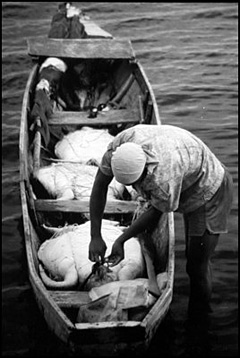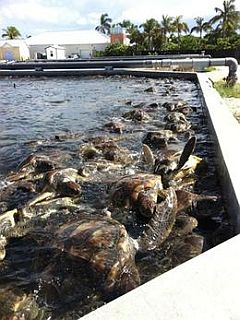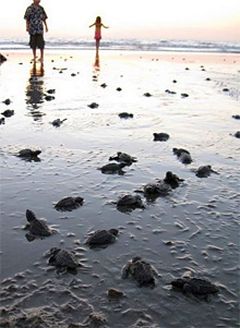Puerto Vallarta, Mexico - Humankind's existence is very short compared to that of the Earth. We have adapted to many natural changes and have proved to be a very resilient species. However, our uncontrolled exploitation of our surroundings has altered the natural ecological balance of the planet and many species have become extinct, death rates are higher and help has not always been there. We have altered so much in so little time, and a behavior change is needed quickly, or else there won't be much to save later.
Nowadays, it is somehow more common to have conversations with words such as global warning, and environmental care. Thankfully, there is a constant growth of concern about respectful and controlled use of natural resources (land, water, air, fauna and flora), but there's still a long road, short cuts need to be found.
 |
However, by the second half of the XVI century, with navigation and increasing commerce, a turtle industry and demand arose. Sea turtles were famous for their meat and eggs (allegedly an aphrodisiac), shell, oil, skin and more... For many years turtles were harvested, hunted and killed by the ton every week, therefore their populations declined.
Human activities tipped the scales against the survival of these animals. Added to that, they had to face habitat destruction and accidental captures of the also overwhelming fishing industry. This was at such degree that all 7 species of sea turtles that exist were facing a critical stage, almost reaching extinction. Something had to be done!
Mexico is home to 6 of these 7 species, the only one not present is the turtle known as the flatback (Natator depresus) only found in Australia. The names of the others are loggerhead (Caretta caretta), hawksbill (Eretmochelys imbricate), green (Chelonia mydas), leatherback (Dermochelys coriacea), Kemp's Ridley (Lepidochelys kempii) and Olive Ridley (Lepidochelys olivacea). All legally hunted until 1990 when this activity and sea turtle commerce was banned. By then, all sea turtles had been placed on the world wide endangered species list and they became protected.
 |
Zooming in a little on Banderas Bay, and closer to our time, it is interesting as much as important to know that during the nesting season, from July to October (sometimes November too), it is very likely to come across an Olive Ridley, and with much luck with a leatherback. So some simple ground rules need to be followed. Although turtle's sight is not one of their best features, they are extremely sensitive to smells, noise, bright lights and sudden movements. As soon as a female sets their flippers on the sand, she is completely exposed and moves very slowly. Therefore, if she feels unsafe, she will not lay eggs and go back to the water.
Once the nest is laid the female goes back to the water. Eggs and babies are on their own from then on. It is known that, due to natural causes, the survival rate of turtles is 1 out of 100. However, due to human exploitation it began to get as low as 1 out of a 1000. But if the turtles make it, approximately 45 days after the eggs were laid; an average of 90 baby turtles will "pop out" of the nest and rush as fast as they can towards the water, their new home.
 |
Participation in a legal turtle release program is another activity through which people can help and learn more about marine turtles.
In Puerto Vallarta and surrounding areas of the Banderas Bay region, there are five important turtle sanctuaries that help prevent eggs poaching and baby turtles deaths caused by human activities. All of them have turtle research and conversancy projects, and are run by Marine specialists.
One of these is located in Nuevo Vallarta, and Superior Tours Vallarta, which is involved in the promotion of environmental care and ecotourism activities around Banderas Bay, has developed a special tour called the "Turtle Encounter."
Every year from July to February, during the turtles' nesting and hatching cycle, professional biologists and certified volunteers patrol the beaches 24 hours a day, to collect the eggs and transfer them to a secure area. On this tour, you will be guided by our marine specialist, who will explain all you need to know about sea turtles, the turtle camp projects, the turtle camp projects and you will be part of these too, since you will help us release turtle hatching into the wild.
Join Superior Tours' marine specialist, Thalia, on an unforgettable adventure and become part of the process that is helping a species' survival by protecting them from their main predator: Humans. Click HERE to book your tour today!
Located in Old Town Puerto Vallarta, Superior Tours is a full service, licensed travel agent and DMC - and the Banderas Bay area's leading Tour and Transportation company - offering customized tours in Vallarta, throughout Mexico and to many other countries. To learn more about Superior Tours Vallarta, click HERE. For more information or to book your tour, visit SuperiorToursVallarta.com.


